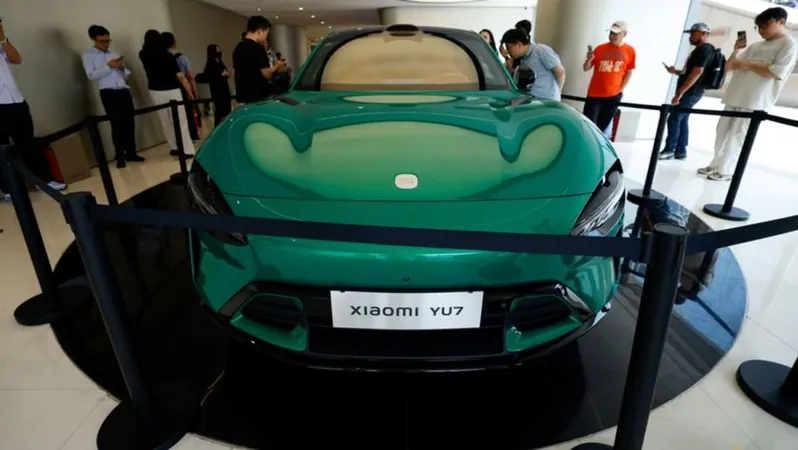
AI Revolution: Why Developers Are Prioritizing Efficiency Like Never Before!
2025-05-25
Author: Li
The Dawn of Model Efficiency in AI Development
As the world of artificial intelligence continues to evolve, one undeniable trend stands out: larger models often equal smarter systems. However, they also demand more computational power, creating challenges for developers globally, especially in regions with limited access to advanced AI chips, such as China.
In an exciting shift, developers are increasingly embracing innovative architectures like Mixture of Experts (MoE) and cutting-edge compression technologies. Nearly three years post the ChatGPT phenomenon, urgency around the costs of running these complex models is finally coming to the forefront.
The Game-Changer: Mixture of Experts (MoE)
MoE models, like Mistral AI's Mixtral, are not new, but their popularity has skyrocketed in the past year. Leading tech giants—including Microsoft, Google, IBM, Meta, DeepSeek, and Alibaba—are now rolling out open-weight LLMs built on MoE technology.
The key advantage? MoE architectures are significantly more efficient than traditional dense architectures. Instead of relying on a single massive model trained with diverse data, MoE directs tasks to smaller, specialized sub-models known as experts, optimizing processes for specific applications such as coding or mathematics.
Breaking the Memory Barrier
First introduced in the early '90s, MoE models not only boost efficiency but also help overcome the memory bottleneck associated with large AI models. While they might not always match the quality of dense models, the striking efficiency gained makes them incredibly attractive.
For instance, DeepSeek's V3 model utilizes 256 routed experts; however, only eight are activated for each token generated. This selective processing means demands on memory bandwidth are significantly lower, allowing for more flexible infrastructure options.
Hands-On Comparison: Dense vs MoE Models
Consider Meta's massive Llama 3.1 405B model, which requires over 405 GB of vRAM and 20 TB/s memory bandwidth to function at 50 tokens per second. In contrast, Llama 4 Maverick—using an MoE architecture—requires less than 1 TB/s, even with a similar memory footprint. This translates into dramatically faster output on the same hardware.
A New Era for AI Hardware
With Nvidia's recently unveiled RTX Pro Servers, which utilize more accessible GDDR7 memory as opposed to expensive high-bandwidth memory (HBM), organizations can now economically run powerful models like Llama 4 Maverick without breaking the bank.
The CPU Renaissance in AI?
Interestingly, CPUs are becoming more competitive in AI scenarios. Intel showcased their dual-socket Xeon 6 platform capable of processing Llama 4 Maverick at 240 tokens per second, proving that for certain applications, high-end GPUs may not be necessary.
Pruning and Quantization: The Efficiency Boosters
To complement MoE’s gains, pruning and quantization techniques are vital in minimizing memory requirements without sacrificing model performance. Strategies reducing weights or compressing models to 8-bit or 4-bit precision can halve the needed bandwidth and capacity, maintaining quality levels.
Innovations on the Horizon
Just last month, Google demonstrated quantization-aware training (QAT) that diminished the size of its models by 4x, closing the quality gap during compression. This innovation shows promise for even lower precision levels, pushing the boundaries of what’s possible in AI.
Conclusion: The Future of AI Efficiency Looks Bright
By combining MoE architectures with low-precision quantization, developers can significantly cut costs and enhance the capabilities of their AI models. As the industry embraces these breakthroughs, the potential for innovation in AI becomes limitless, paving the way for faster, more powerful systems that can operate even under stringent resource constraints.



 Brasil (PT)
Brasil (PT)
 Canada (EN)
Canada (EN)
 Chile (ES)
Chile (ES)
 Česko (CS)
Česko (CS)
 대한민국 (KO)
대한민국 (KO)
 España (ES)
España (ES)
 France (FR)
France (FR)
 Hong Kong (EN)
Hong Kong (EN)
 Italia (IT)
Italia (IT)
 日本 (JA)
日本 (JA)
 Magyarország (HU)
Magyarország (HU)
 Norge (NO)
Norge (NO)
 Polska (PL)
Polska (PL)
 Schweiz (DE)
Schweiz (DE)
 Singapore (EN)
Singapore (EN)
 Sverige (SV)
Sverige (SV)
 Suomi (FI)
Suomi (FI)
 Türkiye (TR)
Türkiye (TR)
 الإمارات العربية المتحدة (AR)
الإمارات العربية المتحدة (AR)